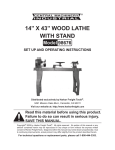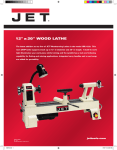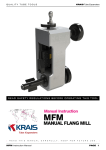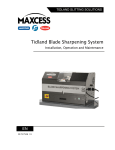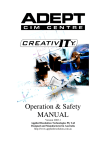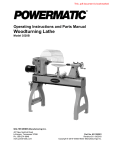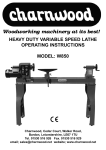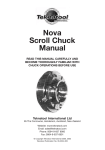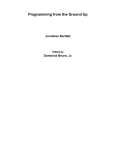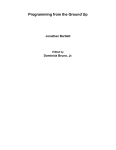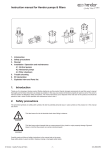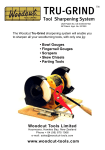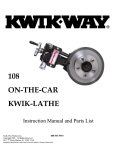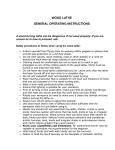Download MACHINE SHOP SAFETY & BASIC USER GUIDE
Transcript
MECHANICAL ENGINEERING MACHINE SHOP – ROOM B155 MACHINE SHOP SAFETY & BASIC USER GUIDE REVISION: V2 DATE: 051712 THE GOLDEN RULES: 1. Safety glasses at all times! Even when just visiting. 2. No long hair and no long sleeves! Pulled back & tied up. 4. No wearing jewelry or watches while working! 3. Closed toe shoes or boots only! No sandals or dressy shoes. 4. ULTIMATELY, YOU ARE RESPONSIBLE FOR YOUR OWN SAFETY! 1|Page Table of Contents Procedures For Working In The Shop ………………………….….………..3 Advanced Machine Shop Use .……………………………..……………………4 Regular And Evening Hours Use Policy ....................................5 General Shop Safety Rules ....................................................6 Guidelines for Medical Emergencies ……………………………….….……8 Drill Press Safety Rules .........................................................9 Grinder Safety Rules ............................................................10 Band Saw Safety Rules .........................................................11 Circular (Skil) Saw Safety Rules ..............................................12 Disc And Belt Sander Safety Rules ..........................................13 Heavy Sanding Of Wood and Foam Safety Rules .....................13 Solvents and Resins Safety Rules ............................................14 Table Saw Safety Rules ……………………………………..……..……………….15 Manual Milling Safety Rules ………………………….………...................16 Manual Lathe Safety Rules .....................................................17 Welding Safety Rules …………………………………………………..….…………18 2|Page Procedures For Working In The Shop Visiting the Machine Shop Visitors are welcome in the shop under certain conditions. First, safety glasses are supplied at the front door and must be worn the entire time of the visit. Second, make sure you find the Shop Manager and inform him/her of your visit immediately. Third, visitors are not allowed to touch or use any tools or equipment. Fourth, visitors are not to interrupt, or interfere with, people working in the shop. Observing is OK, but only with prior permission from Shop Manager and while wearing PPE (personal protective equipment). Getting Started (& Senior Design Students) If you need to do work in the machine shop, you must first study this document. Then you come in to take the Basic Safety Test. This test will be graded by the Shop Manager and any incorrect answers review so that the information is 100% understood by the test taker. Completing this test ONLY gives you permission to be in the machine shop. The use of ANY tools or equipment is still to be supervised and only after prior approval of the Shop Manager. All assigned tasks that involve powered, electronic equipment must have the Shop Manager’s approval and supervision. Basic users will be shown how to perform specific tasks and limited to just those tasks. There is no official machine shop training program or class at UCR ME, so users are shown how to perform certain tasks based on what they specifically need to get done. Shop Volunteers If you would like to volunteer to help in the machine shop, you must take and pass the shop safety test described above. Volunteers are required to help with many different tasks in the machine shop, in return they get to observe and learn the many aspects of machine shop operations. This is not an official training program, but a way for students to acquire many hands-on skills and practices. Shop Record Keeping All tests (graded and blanks) are kept in the Shop Manager’s office. Copies of all machine shop documents (except tests) are available as PDFs on UCR Mechanical Engineering’s Machine Shop web page: http://www.me.ucr.edu/machine_shop.html Copies of Basic Safety Tests & Basic User Safety Tests (aka BUSTs) are available from the Shop Manager or Department Manager. 3|Page Advanced Machine Shop Use For those that want to use the more advanced machines, such as Mills, Lathes and Welders, you will need to study the SOPs (Standard Operating Procedures) for those specific machines. These SOPs are available on the UCR ME Machine Shop web page: http://www.me.ucr.edu/machine_shop.html Steps to using advanced machine shop equipment: 1. After studying the SOPs, the users will then have to take the BUSTs (Basic Use & Safety Test). 2. These tests are then graded by the Shop Manager. 3. A hands-on skills assessment is done where the users must show competency in use of that machine and that they understand the basics of safe operation. 4. A log is kept on the progress of the user’s experience. This is based on hours or number repetitions a user does specific operations. These logs are the last page of the BUST documents (see list below) 5. Below 4 hours (and/or below 8 repetitions of specific tasks), the users must be supervised during set-up and during certain operations. Log kept on last page of BUST document. 6. After logging 4 hours (and/or above 8 repetitions of specific tasks), the users are allowed to perform those specific tasks (only) without direct supervision. Log kept on last page of BUST document. 7. In either case, the Shop Manager must be informed of what tasks and/or operations the user wants to perform. 8. Users are to ALWAYS ask, and get assistance with, any new or unusual work to be done in the machines. 9. Regardless of user experience, the amount of time before they can use the machine without supervision is still at the discretion of the Shop Manager. 10. Advanced users are NOT allowed to perform tasks during evening hours that they have not been trained to do. 11. Any unsafe or improper use of machine, not listening to or following instructions, or lack of judgment will result in a warning and possibly loss of shop use privileges. Related Documents: 1. Manual Milling Machines a. UCR-ME-SOP-Manual-Milling-Machines.PDF b. UCR-ME-BUST-Manual-Milling-Machines.PDF 2. Manual Lathes a. UCR-ME-SOP-Manual-Lathes.PDF b. UCR-ME-BUST-Manual-Lathes.PDF 4|Page Regular & Evening Hours Use Policy Regular Shop Hours Regular Hours are Monday through Friday, 8am to 5pm. Closed for lunch 12pm-1pm. Evening Hours policy also applies to Regular Hours when the Shop Manager is not available. Shop may be available to certain pre-authorized users at any time. Evening Hours Shop use is available (to authorized grad students, in pairs) from 5pm to 11pm weeknights. Those using the shop after hours must first read & sign the “SHOP HOURS and USE POLICY.doc” available on the UCR ME Machine Shop web page: http://www.me.ucr.edu/machine_shop.html The text of that document is below: Prior PI (Principal Investigator, AKA Professor) approval is necessary for evening hours shop use. PI is responsible for the safety of his/her graduate students while in the machine shop. Must have a shop buddy (of equal training level) with you at all times. All existing safety rules and procedures must be followed while in the shop. You AND your shop buddy MUST sign in and out of the EVENING HOURS LOG BOOK. ONLY authorized users are allowed in the shop after hours, no friends or guests. Door must be left open while you are in the shop, then closed / locked when you leave. You must have passed the BUST (Basic User Safety Test) before using that particular equipment. You must report any broken, damaged or malfunctioning equipment. You must have passed all necessary UCR (on-line) safety training. You may ONLY use equipment that you have been trained on and can use safely. All tools or equipment used and the shop, should be left clean and organized every time. DO NOT use any equipment if it is not functioning correctly or you are unsure. In case of an emergency or accident, call Campus Emergency 951-827-5222. Shop Manager must also be immediately notified if there are ANY accidents. Closed Hours The shop is closed during the week from 11pm to 8am, and on weekends from Friday 11pm to Monday 8am. 5|Page General Shop Safety Rules 1. Safety glasses, or appropriate goggles / face shields are required in the shop, whether working or not!! 2. Shoes must be worn in any shop area. No one wearing sandals will be allowed to enter any shop area. The minimum footwear must cover the entire foot. 3. Do not operate any item of equipment unless you are familiar with its operation and have been authorized to operate it. If you have any questions regarding the use of equipment ask the Shop Manager. 4. Avoid excessive use of compressed air to blow dirt or chips from machinery to avoid scattering chips. Never use compressed air guns to clean clothing, hair, or aim at another person. 5. In case of injury, no matter how slight, you must report it to the Shop Manager. The main UCR emergency number is 951- 827-5222. 6. Do not attempt to remove foreign objects from the eye or body. If chemicals get in the eye(s), wash eye(s) for 15 minutes in an open flow of water before proceeding for medical treatment. Notify the Shop Manager immediately. 7. Machines must be shut off when cleaning, repairing, or oiling. 8. Do not wear ties, loose clothing, long sleeves, jewelry, gloves, etc. around moving or rotating machinery. Long hair must be tied back or covered to keep it away from moving machinery. Hand protection in the form of suitable gloves should be used for handling hot objects, glass or sharp-edged items. 9. Wear appropriate clothing for the job (i.e. do not wear short sleeve shirts or short pants when welding). 10. Do not work in the shop if tired, or in a hurry. 11. Never indulge in horseplay in the shop areas. 12. All machines must be operated with all required guards and shields in place. 13. A brush or gentle air blasts should be used for removing chips, shavings, etc. from the work area. Never use your hands. 14. Keep all body parts clear of the point of operation of machines by using special tools or devices, such as, push sticks, hooks, pliers, etc. NEVER use a rag near moving machinery. 15. A hard hammer should not be used to strike a hardened tool or any machine part. Use a soft faced hammer. 16. Practice cleanliness and orderliness in the shop areas. Never leave a dirty piece of equipment. 17. Keep the floor around machines clean, dry and free from trip hazards. Do not allow chips to accumulate. 18. Think through the entire job before starting. Ask the Shop Manager if you are ever unsure for any reason. 6|Page 19. Before starting a machine, always check it for correct setup and always check to see if machine is clear by operating it manually, if possible. 20. Food is allowed in the machine shop, but only in specific areas, well away from any chemicals or contaminants. 21. Don't rush or take chances. Don’t say you know how to do something, when you don’t. Obey all safety rules at ALL times. 22. If you have not worked with a particular material before, check the hazardous materials data sheets book for any specific precautions to be taken while working with the material. Also, ask the Shop Manager before cutting any unusual material. 23. Heavy sanding and painting should only be done in well ventilated areas, preferably outside. 24. Follow all appropriate precautions when working with solvents, paints, adhesives or other chemicals. Use appropriate personal protective equipment. 25. Check the power cords and plugs on portable tools for before using them. 26. Always store oily rags in an approved metal container. 27. Obey all posted signs, warnings, posters and special instructions. 7|Page Guidelines for Student Medical Emergencies Serious Injuries that Threaten Life or Limb. 1. 2. 3. 4. 5. Notify Shop Manager! Call 827-5222 from a cell, or 2-5222 from the shop office phone, or 911 (response might be delayed). Request an ambulance, give location (UCR, Bourns “B” building, bottom floor, Room B155) Describe the nature of the problem and stay on the phone. If alone, watch for emergency personnel and guide them to the victim. Otherwise, send someone. Emergencies Which Might Need Professional Care. 1. Notify Shop Manager! 2. Follow these procedures if you are unsure of the severity of an injury (broken vs. sprained, etc…) 3. If transportation is available, take victim to nearest hospital or care center. a. Campus Health Center – Located across from Parking Lot #15 i. 951-827-3031 - Mon-Fri 8:00am – 4:30pm, Thu 9:00am – 4:30pm b. Riverside Community Hospital – 4445 Magnolia Ave, Riverside. i. 951-788-3000 - 24 hours a day. 4. If transportation is not available, follow the procedures for “Serious Injuries” above. Minor Emergencies Not Requiring Professional Care. 1. 2. 3. 4. Notify Shop Manager! Provide appropriate first aid. Help victim to rest comfortably. Reassure victim and encourage them to seek additional care if necessary. Emergencies involving Staff, Volunteers and Grad Students. 1. In addition to above actions, refer to the “Injuries / Medical Treatment Chart” located above the shop sink. Additional References. 1. http://safety.ucr.edu 2. www.campushealth.ucr.edu 8|Page Drill Press Safety Rules 1. Run drill at correct RPM for diameter of drill bit and material. Ask Shop Manager for the correct RPM. 2. Always hold work in a vise or clamp to the drill table. NEVER hold it by hand! 3. Use a correctly ground drill bit for the material being drilled. Shop Manager can help select the correct bit. 4. Use the proper cutting fluid for the material being drilled. Ask the shop staff about the appropriate fluid for the material you are machining. 5. Remove chips with a brush, NEVER by hand. 6. Ease up on drilling pressure as the drill starts to break through the bottom of the material. 7. Don't use a dull or cracked drill. Inspect the drill before using. 8. Don't drill with too much pressure. 9. Always try to support part on parallels or a backing board when drilling through any material. 10. Never place taper shank tools such as large diameter drills or tapered shank reamers in a drill chuck. Only straight shank tools such as standard drills can be clamped in chucks or collets. 11. Always clean drill shank and/or drill sleeve, and the spindle hole before mounting. 12. Remove taper shank tools from spindle or sleeve with a drill drift and hammer. 13. Never try to loosen the drill chuck while the power is on. 14. Never clean the machine while it is in motion! 15. If the drill binds in a hole, stop the machine and turn the spindle backwards by hand to release the bit. 16. When drilling a deep hole withdraw the drill bit frequently to clear chips. 17. Always remove the drill chuck key or the drill drift from the spindle immediately after using. 18. Wear safety eye protection while drilling. 19. Let the spindle stop of its own accord after turning the power off. Never try to stop the spindle with your hand. 20. Plexiglas and other brittle plastics can be difficult to drill. Ask the Shop Manager for advice on drill and coolant selection when drilling these materials. 9|Page (Bench and Surface) Grinder Safety Rules 1. Abrasive wheel machinery shall not be operated without the appropriate guards in place. 2. Toolrests on bench or pedestal grinders shall be set no more than 1/8 inch from the wheel. 3. Never use a wheel that has been dropped or received a heavy blow, even though there may be no apparent damage. Such wheels may be weakened or unbalanced enough to fly apart on startup. 4. Stand to one side when starting machine. 5. Do not grind on side of wheel unless wheel is specifically designed for such use. 6. Do not use excessive pressure while grinding. On surface grinder do not exceed .0005” inch downfeed at any time. 7. Report to the Shop Manager immediately any cracked, broken or otherwise defective wheels. 8. Have the Shop Manager mount and balance new wheels. 9. Keep the grinding wheel dressed. Dressing a small amount frequently is better than having to dress a lot later and will allow the wheel to cut faster, cooler and with a better surface finish. Dressing is cleaning and smoothing the surface of the grinding wheel. 10. Hold work securely while grinding, use the toolrest to support the work when off-hand grinding on bench or pedestal grinders. 11. Do not grind aluminum. It will clog the wheel and aluminum dust is explosive. Check with shop staff for safety instructions if aluminum must be ground. 12. Always wear safety glasses when grinding on bench or pedestal grinders. The addition of a face shield is recommended. 13. If a magnetic chuck is being used, on the surface grinder, make sure it is holding the work securely before starting to grind. 10 | P a g e Band Saw Safety Rules 1. The upper guide and guard should be set as close to the work as possible, at least within 1/2 inch. 2. If the band breaks, immediately shut off the power and stand clear until the machine has stopped. 3. Examine blade before installing to see if it is cracked, do not install a cracked blade. 4. Use the proper pitch blade for the thickness of the material to be cut. There should be at least 3-4 teeth in the material when cutting. 5. Do not run the band saw at a higher speed than recommended for the material being cut. 6. If the saw stalls in a cut, turn the power off and reverse the blade by hand to free it. 7. Band saw rpm is to be adjusted while the band saw is running. Band saw speed range is adjusted when the machine is stopped. 11 | P a g e Circular (Skill) Saw Safety Rules 1. Before using any power tool, inspect it to make sure the cord is not damaged in any way, that the ground pin is intact, and that the blade is sharp and undamaged. 2. Do not use the saw, or any other power tools, in a wet area. 3. Do not run the extension cord across walkways where people might trip over it or where the cord may be run over and damaged. 4. Keep your head out of the path of particles thrown out by the blade. Wear eye protection. 5. Disconnect the power cord before cleaning, changing blades, or making any adjustments to the saw. 6. When it is necessary to raise the guard for certain types of cuts, use the guard lever. 7. Never wedge, wire, or otherwise jam the guard to prevent it from working. This is a particularly dangerous practice and will cause your permission to work in the machine shop to be revoked immediately!!! 8. Wait until the saw stops before lifting it from a cut. 9. Before setting the saw down, make sure the guard is closed, as the blade may still be turning. 10. Don't carry the saw with your fingers on the switch trigger. 11. Don't pull the saw backwards in a cut if you can avoid it. 12. Use the proper blade for the type of cut to be made. 13. Do not use the cord to move or drag the saw. 14. Do not use the power hand saw for cuts if you cannot keep a firm and secure grip on the saw and the material being cut. A hand saw is still the best for some kinds of work and often faster. 15. Before cutting small work pieces, the Shop Manager should be consulted. 12 | P a g e Disc and Belt Sander Safety Rules 1. Do not operate sanders without the guards in place. 2. On the disc sander always use the downward motion side of the disc to sand. Never the upward motion side as this can throw your part upwards with tremendous force. 3. Always attempt to place your work against the rest on the disc and belt sanders. 4. On the horizontal belt sander, always sand so that the belt motion is away from you. 5. Do not operate machines with torn or ripped belts or disks. 6. Do not sand any material that will give off a dangerous dust. Such materials as beryllium or copper beryllium alloys must not be sanded or filed. Asbestos must not be sanded. Always ask the Shop Manager if you are unsure. 7. Sweep / vacuum all particles when you are done sanding. Heavy Sanding of Wood and Foam Safety Rules 1. Sand in a well ventilated area; away from other machines (preferably outside). 2. Use a vacuum or a dust collector to collect dust while sanding to prevent the dispersal over a large area. 3. A dust mask must be worn. They are stored in the safety cabinet. 4. Safety glasses must be worn. 5. Entire area must be cleaned when you are done for the day. 13 | P a g e Safety Rules for Working with Solvents and Resins 1. Avoid skin contact. Wear latex or nitrile gloves. Check for chemical to glove compatibility first! 2. Work in a well ventilated area. When respirators are necessary ask the Shop Manager for assistance. 3. Avoid using solvents around hot metal surfaces and flames. 4. Do not smoke or light flames in areas where solvents are used and stored. 5. Report and clean up any spills immediately. Let the Shop Manager know immediately. 6. Do not work with solvents in confined, unventilated areas. 7. Do not drink alcoholic beverages or take medications containing alcohol before or during working with solvents. Alcohol in the bloodstream sometimes causes synergistic reactions with various solvents that can lead to loss of consciousness, and even possibly, death. 8. Report any ill effects and skin disorders to the Shop Manager. 9. Develop and maintain good personal hygiene habits. Remove protective equipment and wash thoroughly after contact with solvents. 10. Fumes from paints, solvents, adhesives, and the abrasive cut-off saw used on the patio can drift into the shop. 11. Mix resins in small batches and in correct containers. 14 | P a g e Table Saw Safety Rules 1. Stand to one side of the work being fed through the saw. Never stand directly in line of the work. 2. Use the proper blade for the material and the type of cut. Do not use a rip blade for cross cutting or a crosscut blade for rip sawing and do not use a plywood blade for anything but plywood. 3. Inspect the blade before using it. Make sure it is the proper blade and make sure the blade is sharp and free from cracks or defects. 4. Never allow your fingers to get near the blade when sawing. Use a pusher stick to rip narrow pieces of stock. Do not use a pusher stick to remove scrap. For scrap removal, shut off the saw, wait until the blade comes to a complete stop, and then remove the scraps. 5. Appropriate guards must be in place at all times. 6. If the piece of material that you are cutting is too large for one person to handle safely, get someone to assist you in “tailing-off” the excess material. Never try to do it alone. “Tailing-off” refers to supporting a large workpiece by supporting it underneath with your hands. Do not grasp it, just support the vertical load. 7. If you are “tailing-off” for someone else let them guide the work through the saw. You should just support the work without influencing the cut. 8. Never reach over the saw to obtain something from the other side. 9. When shutting off the power, never attempt to stop the saw by shoving an object, piece of work, or anything else against the blade. Make sure the saw has stopped completely before leaving work area. 10. Never make any adjustments or measurements while the saw is in motion! Always turn off the power and make sure that the saw has made a complete stop before making any necessary adjustments or measurements. 11. Do not allow material to collect on or around the table saw. Sweep up all sawdust and material scraps regularly while working to minimize chances of slipping or stumbling. 12. Make sure that work area is cleaned up thoroughly. Unclean work areas can cause accidents. 13. The blade of the circular saw should always be set to 1/8 of an inch above the workpiece to prevent kickback. 14. Always obtain shop approval and permission before using the table and/or radial-arm saw! 15 | P a g e Milling Machine Safety Rules (See Manual Mill SOP for more details) 1. Work must be clamped securely in a vise and vise clamped tightly to the table, or, work must be clamped securely to the table. 2. Do not take climb milling cuts on the shop’s mills unless instructed to do so. 3. Make sure cutter is rotating in the proper direction before cutting material. 4. Before running machine the spindle should be rotated by hand to make sure it is clear for cutting. 5. Make sure the power is off before changing cutters. 6. Always use the proper cutting fluid for the material being cut. 7. Never run the machine faster than the correct cutting speed. 8. Make sure that the machine is fully stopped before taking any measurements. 9. Always use cutters which are sharp and in good condition. 10. Don't place anything on the milling machine table such as wrenches, hammers, or tools. 11. Always stay at the machine while it is running. 12. Don't take too heavy a cut or use too rapid a feed. 13. Remove the collet tightening wrench immediately after using it. 14. If at all feasible, add a shield to prevent chips from hitting other people. 15. Use the milling machine spindle brake to stop the spindle after the power has been turned off. 16. Before cleaning the mill remove cutting tools from the spindle to avoid cutting yourself. 17. The Manual Mill SOPs must be read and understood. Then the Manual Mill BUST (Basic Use and Safety Test) must be passed before you are allowed to use the manual mills(s). The Manual Mill SOP is available on the UCR ME Machine Shop web page: http://www.me.ucr.edu/machine_shop.html 16 | P a g e Lathe Safety Rules (See Manual Lathe SOP for more details) 1. Make sure that the chuck or faceplate is securely tightened onto the lathe spindle. 2. When removing the chuck or faceplate do not use machine power. 3. When installing the chuck or faceplate do not use machine power. 4. Move the tool bit a safe distance from the collet or chuck when inserting or removing work. 5. Don't run the machine faster than the proper cutting speed. 6. Always clamp the toolbit as short as possible in the toolholder to prevent it from breaking or chattering. 7. Always make sure that the toolbit is sharp and has the proper clearance. Ask for assistance making adjustments. 8. Do not file on the lathe, unless you have a large amount of experience and have the Shop Manager’s approval. 9. If work is turned between centers, make sure that proper adjustment is made between centers and that the tailstock is locked in place. 10. If work is being turned between centers and expands due to heat generated from cutting, readjust centers to avoid excessive friction. 11. Do not grasp or touch chips or turnings with your fingers, but get rid of them using a blunt instrument. It is safer to turn off the lathe before clearing chips then to leave it running. 12. Set the toolbit on center line of work to prevent work from climbing over tool or cutting above center and dragging. 13. Remove chuck key from chuck immediately after using. 14. Turn chuck or faceplate through by hand before turning on the power to be sure there is no binding or clearance problems. 15. Stop the machine before taking measurements. 16. Before cleaning the lathe, remove tools from the tool post and tailstock. 17. The Manual Lathe SOPs must be read and understood. Then the Manual Lathe BUST (Basic Use and Safety Test) must be passed before you are allowed to use the lathe(s). The Manual Lathe SOP is available on the UCR ME Machine Shop web page: http://www.me.ucr.edu/machine_shop.html 17 | P a g e Welding Safety Rules 1. Welders, assistants, and anyone else in the welding area shall wear glasses or shields of recommended shades during welding operations. 2. Inspect all welding equipment to be used, prior to each use, for possible damage. 3. Avoid handling oxygen bottles with greasy hands, gloves or rags. Fatal explosions have resulted from this. 4. Always strap tanks to a welding cart or a fixed object. Never allow a gas cylinder to be free standing. Replace the safety cap on all cylinders when not in use. 5. When doing any kind of TIG/ARC/MIG welding, make sure work and/or work table is properly grounded. 6. Do not weld in or near a wet area or with wet gloves/hands. 7. Be alert to possible fire hazards. Move the object to be welded to a safe location, or, remove all flammable materials from the work area. 8. Never weld in the same area where degreasing or other cleaning operations are performed. 9. Keep suitable fire extinguishing equipment nearby and know how to operate it. 10. Shut off the cylinder valves when the job is completed, release pressure from the regulators by opening the torch valves momentarily and back out regulator adjusting valves. Never leave the torch unattended with pressure in the hoses. 11. Utilize all protective equipment and clothing. Do not weld with any part of the body uncovered, the arc light will cause burns similar to severe sunburn. 12. Never weld inside drums or enclosed spaces without adequate ventilation, or, the use of airline respirators or self-contained breathing apparatus. 13. Check the ventilation system before starting to weld and periodically thereafter to insure adequate performance. Welding fumes should not be allowed to get into the rest of the shop working areas. 14. Never cut or weld any container that has held explosive or flammable materials. 15. Abide by any other safety measures required for each particular type of welding. 16. Allow for proper ventilation when brazing or soldering. The fluxes are acidic and toxic. 17. Do not weld on painted, galvanized or greasy, oily metals. Not only can the fumes be toxic, but the welds will not be satisfactory and will fail in use. 18. The Welding SOPs must be read and understood. Then the Welding BUST (Basic Use and Safety Test) must be passed before you are allowed to use the welding equipment. The Welding SOP is available on the UCR ME Machine Shop web page: http://www.me.ucr.edu/machine_shop.html 18 | P a g e


















